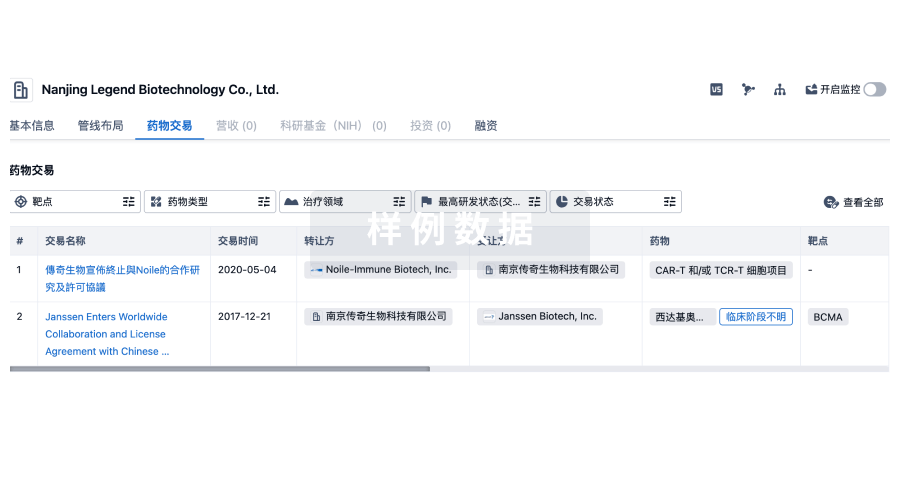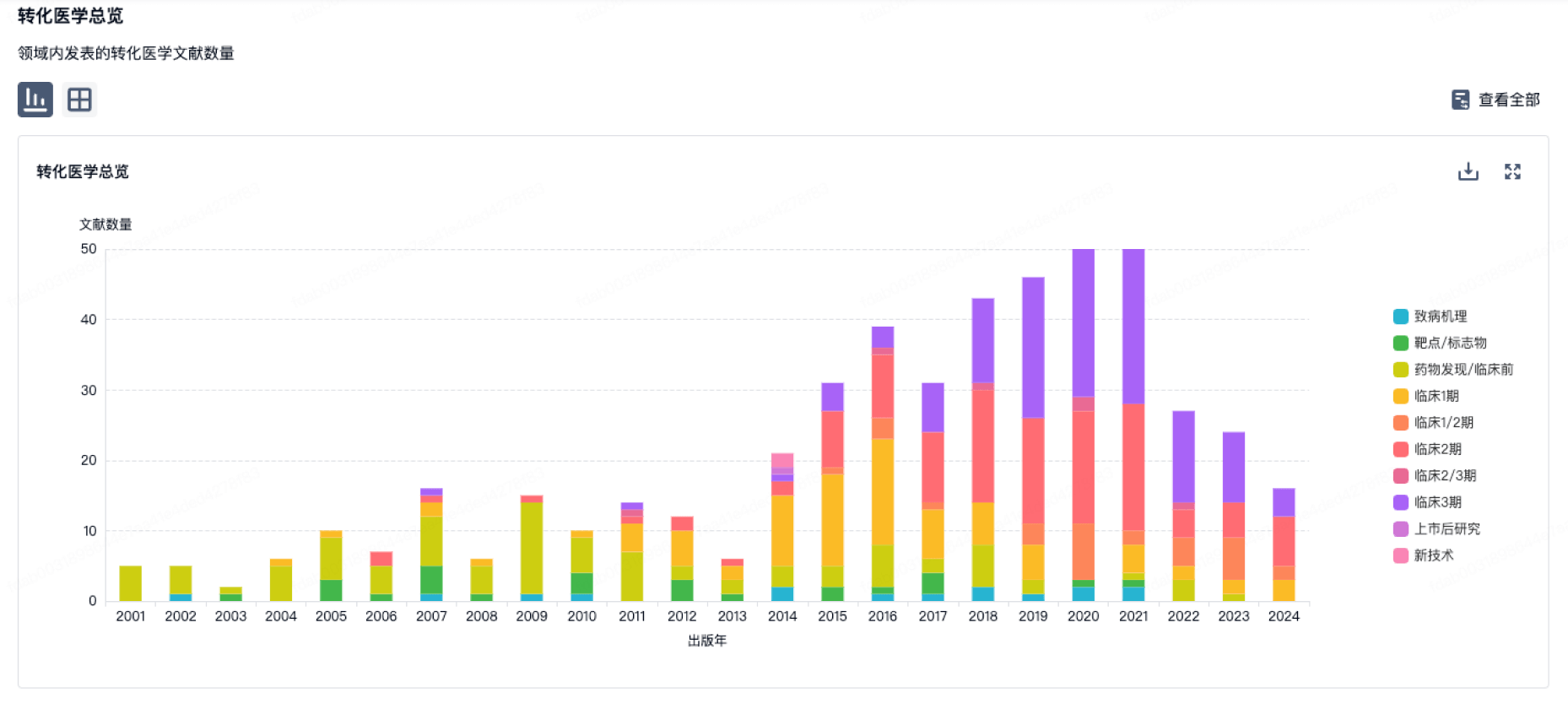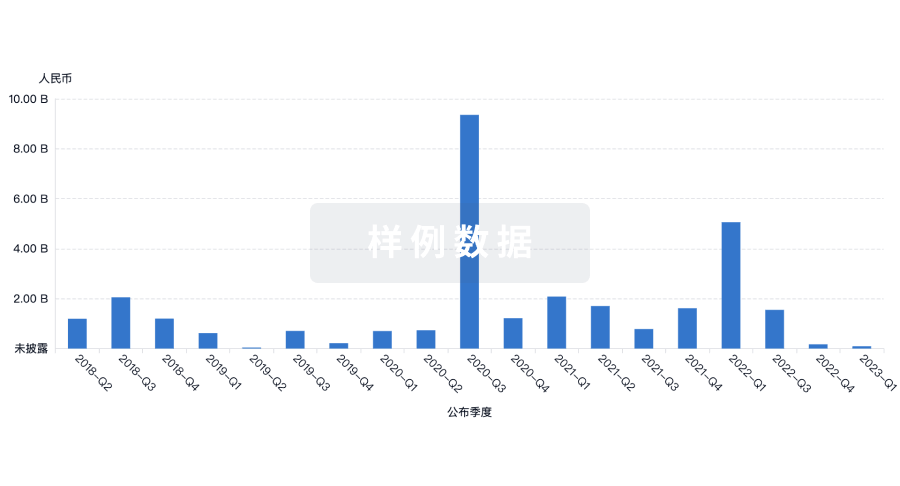预约演示
更新于:2025-12-09

Stanford University
更新于:2025-12-09
概览
标签
肿瘤
其他疾病
血液及淋巴系统疾病
小分子化药
蛋白水解靶向嵌合体(PROTAC)
自体CAR-T
疾病领域得分
一眼洞穿机构专注的疾病领域
暂无数据
技术平台
公司药物应用最多的技术
暂无数据
靶点
公司最常开发的靶点
暂无数据
| 排名前五的药物类型 | 数量 |
|---|---|
| 小分子化药 | 72 |
| 蛋白水解靶向嵌合体(PROTAC) | 33 |
| 诊断用放射药物 | 13 |
| 化学药 | 8 |
| 降解型分子胶 | 5 |
关联
180
项与 Stanford University 相关的药物靶点 |
作用机制 CTLA4抑制剂 |
最高研发阶段批准上市 |
首次获批国家/地区 美国 |
首次获批日期2011-03-25 |
靶点 |
作用机制 EGFR拮抗剂 |
在研机构 |
原研机构 |
在研适应症 |
最高研发阶段批准上市 |
首次获批国家/地区 美国 |
首次获批日期2006-09-27 |
2,867
项与 Stanford University 相关的临床试验NCT05945147
Feasibility Study Comparing a Ketamine and Midazolam Infusion to a Midazolam-Only Infusion for Complex Regional Pain Syndrome
This study will assess the feasibility of administering ketamine plus midazolam or midazolam alone, when infused over 5 days in an outpatient setting, to adults with complex regional pain syndrome (CRPS).
开始日期2099-01-01 |
申办/合作机构 |
NCT04027569
PROMs To Improve Care: A Pragmatic RCT on Standardized and Patient Specific PROMs on Outcomes After Hand Surgery
To examine the impact of using 2 validated PROMs during the care of an orthopaedic condition on shared decision making, patient centered care, and patient outcomes.
开始日期2040-11-01 |
申办/合作机构 |
NCT04291170
Comparison of Upper Extremity and Lower Extremity Function and Quick DAS
Patient reported outcome measure (PROM) are a method by which to assess outcomes from a patient perspective. The QuickDASH is a commonly used PROM. QDASH was validated against grip strength and ability work, however not against its ability to actually measure what it sets forth to measure (ie: patient's ability to use a hammer, carry a shopping bag, wash a wall, etc). The purpose of this study is to correlate the self-reported QDASH with patients' ability to perform the functions on the QDASH and compare to a control group who completes the task on a lower extremity PROM, KOOS JR.
开始日期2040-09-01 |
申办/合作机构 |
100 项与 Stanford University 相关的临床结果
登录后查看更多信息
0 项与 Stanford University 相关的专利(医药)
登录后查看更多信息
154,727
项与 Stanford University 相关的文献(医药)2026-04-01·BIOMATERIALS
Engineering biomimetic tissue barrier models on chips: From design and fabrication to applications in disease modeling and drug screening
Review
作者: Enrico, Alessandro ; Tirpáková, Zuzana ; Shah, Shilp ; Gokce, Begum ; Madadelahi, Masoud ; Zhu, Yangzhi ; Bijarchi, Mohamad Ali ; Jain, Saumey ; Sendemir, Aylin ; Van Gastel, Dirkje ; Gulicli, Baris ; Herland, Anna ; de Barros, Natan Roberto ; Nikmaneshi, Mohammad Reza ; Nasiri, Rohollah ; Morcimen, Zehra Gul ; Lauschke, Volker M ; Khademhosseini, Ali ; Habibey, Rouhollah ; Taebnia, Nayere ; Dokmeci, Mehmet Remzi ; Pratx, Guillem
Replicating the in vitro properties of tissue barriers-such as the blood-brain barrier, gut, skin, lung, kidney, retina, nasal epithelium, and placenta-is crucial for many applications, including drug screening, studying molecular transport, drug delivery, and disease modeling in preclinical studies. Organ-on-a-chip (OoC) platforms are advanced three-dimensional (3D) in vitro models that aim to replicate various aspects of organ functionality within microfluidic systems by providing microenvironments akin to native tissue. When used to model the interface between two different tissue compartments, OoC technology offers a promising platform for more accurately replicating the physiology and pathophysiology of various tissue barriers in the body. This review focuses on the state-of-the-art biomimetic tissue barrier models, ranging from two-channel tissue barrier-on-a-chip systems with a thin porous membrane to hydrogel-based membrane models. Specifically, it explores the engineering of tissue barrier-on-a-chip platforms, highlighting various fabrication techniques for microfluidic chips and membranes, as well as methods for functional characterization of the engineered tissue barriers. Additionally, we discuss the development of organ-specific barrier models and multi-organ-on-a-chip systems for studying inter-organ communication. Finally, we highlight the current challenges in the field and future directions in advancing tissue barrier modeling using OoC technology.
2026-03-01·BIOMATERIALS
Spontaneous upregulation of stemness and 3D spheroid formation of single cancer cells induced by scaffold-free polypeptide polyelectrolyte multilayer coating
Article
作者: Chang, Ying-Chih ; Wu, Yi-Chun ; Liu, Chia-Chun ; Wang, Lucas ; Jiang, Hang-Shiang ; Frank, Curtis W ; Huang, Chun-Jen ; Chen, Jia-Yang ; Guo, Chin-Lin ; Pegram, Mark D ; Lu, Pei-Syuan
Three-dimensional (3D) cell structures, such as tumor spheroids, have emerged as essential tools in cancer research. However, current scaffold-free planar platforms designed to maintain 3D cell structures, including hydrogel-based low-adherence attachment plates, face limitations in handling rare cell samples and achieving high-throughput spheroid formation. We address these challenges by presenting a polyelectrolyte multilayer (PEM)-based surface coating designed to promote rapid spheroid formation from individual cancer cells. The coating was developed using a layer-by-layer deposition of poly-L-lysine and poly-L-glutamic acid, with the number of layers adjusted to tailor the surface hydrophilicity, charge neutrality, and mechanical dissipation capacity. The human colorectal carcinoma cell line HCT116 was used to assess the effectiveness of spheroid formation on this coating. When both surface charge neutrality and mechanical dissipation capacity were enhanced, we observed nearly 100 % efficiency in spheroid formation from single cells within three days, surpassing conventional scaffold-free techniques. Spheroid growth on this platform relies on EpCAM and exhibits enhanced expression of stemness and mixed epithelial/mesenchymal markers. The rapid expansion of individual cells on this platform can be utilized for high-throughput ex vivo applications, thereby advancing our understanding of cancer biology and facilitating the development of effective therapies.
2026-02-01·RHEUMATIC DISEASE CLINICS OF NORTH AMERICA
Overview of Climate Change, Pollution, and Sustainability in the Rheumatic and Autoimmune Diseases
Review
作者: Katsumoto, Tamiko R ; Miller, Frederick W
Most rheumatic and autoimmune diseases evolve over years from gene-environment interactions. Here, we consider the roles of climate change and pollution in this process and how we can minimize disease risks, enhance prevention, and promote sustainable activities to combat environmental degradation. The warming planet-with resultant increased heat effects, extreme weather events, wildfires, ultraviolet radiation, vector borne and zoonotic diseases, psychosocial stress, and pollution of water, food, and air-is likely increasing the rates and severity of these diseases. More research and coordination are needed to assess and quantify these impacts and develop optimal preventative and sustainable approaches.
3,919
项与 Stanford University 相关的新闻(医药)2025-12-09
点击上方蓝字 关注我们
编者按:在我国,每年脑转移瘤新发病例超150万,是颅内肿瘤的第一大病种。因脑部解剖结构复杂且存在血脑屏障,传统手术、化疗及普通放疗各有局限。临床亟需新技术、新方法以提高脑转移瘤诊疗水平。
2025年12月8日,“中国颅内转移瘤协作组(CLAIM)学术论坛暨首都医科大学宣武医院ZAP-X IIT研究启动仪式”顺利举行。该IIT研究由宣武医院神经外科主任张鸿祺教授担任主要研究者(PI),CLAIM提供学术指导,旨在进一步探索全球领先的脑肿瘤精准放疗设备——ZAP-X放射外科机器人在脑转移瘤患者中的临床疗效与安全性、剂量学特征。
ZAP-X IIT研究启动仪式
(从左往右依次为:宣武医院神经外科主任张鸿祺,宣武医院副院长、雄安宣武医院院长李嘉,天津市环湖医院党委书记葛乐,宣武医院院长赵国光,宣武医院党委书记管仲军,百洋医药集团董事长付钢,ZAP Surgical创始人、CEO John Adler,宣武医院副院长洪韬,百洋医药创新药械副总裁王必全)
直面临床需求,脑转移瘤治疗迎来关键窗口期
作为晚期肿瘤的重要标志,脑转移是当前肿瘤治疗的难点之一。全球每年新增约2000万例癌症患者,其中20%-40%会发生脑转移[1,2]。以我国发病率最高的肺癌为例,脑转移比例高达20%~65%[3]。
脑转移瘤患者数量庞大,疾病负担沉重。因其治疗难度高、预后差,涉及多学科协作,需要精准治疗,因此成立一个汇集多学科力量的全国性协作组具有重要现实意义。2025年2月22日,CLAIM在国家神经疾病医学中心-首都医科大学宣武医院、中国国际神经科学研究所等10家国内医院的共同发起下成立,旨在通过整合多学科资源,推动脑转移瘤的规范化诊疗和科研合作,最终提升我国脑转移瘤的诊治水平。
此次ZAP-X IIT研究,是CLAIM成立以来的重要学术进展。ZAP-X是射波刀发明人约翰·艾德勒(John R. Adler)专为颅内及头颈肿瘤、病变设计的精准放疗设备,拥有全球首创完全自屏蔽、数千个非共面角度和实时影像剂量双重监控等创新特性,为脑转移瘤精准放疗技术带来了新的突破。2024年11月,百洋医药通过战略投资引入ZAP-X,并推动其在中国市场的临床落地与全球化制造。
ZAP-X火星舟放射外科机器人
宣武医院作为国家神经疾病中心,肩负面对疾病“科学探索、规范诊疗、新方法应用”的重要使命。而公立医院的高质量发展要体现“新质生产力”,核心方式在于大力推动科研创新。
此次在雄安宣武医院安装ZAP-X并开展临床研究,既是医学前沿技术的探索,也是促进大型设备国产化落地的助力,更是建设国家级区域医疗中心、服务“千年大计”的积极实践。
据介绍,ZAP-X IIT研究是一项前瞻性、单臂、多中心临床研究,计划在天津市环湖医院、北京大学肿瘤医院、中国医学科学院肿瘤医院、中国人民解放军第五医学中心等多家CLAIM成员单位纳入患者,在雄安宣武医院单中心统一治疗,最后在多中心进行综合治疗和随访。
研究计划纳入120例脑转移瘤患者,分成初治脑转移瘤和难治或复发脑转移瘤两个队列。主要研究终点是三个月的局部控制率,次要研究终点包括其他疗效指标、剂量特征指标及安全性等,计划于2026年4月正式开始入组。
立足循证,多中心合作创新勾勒脑肿瘤医学新图景
ZAP-X于2017年9月在美国注册获批上市,2019年在中国人民解放军总医院装机进行临床试验,2023年6月20日获得国家药品监督管理局的创新产品注册批准在中国上市。截至目前,ZAP-X已获全球24个国家及地区的上市许可,完成超过5000例临床治疗。
ZAP-X首个病例系列研究显示,针对20例患者的118个脑转移灶治疗后的5个月中位随访期内,病灶局部控制率达到100%[4]。另一项纳入100例各类颅内肿瘤患者的前瞻性研究也证实,ZAP-X治疗后的首次影像学随访即显示肿瘤体积显著缩小,91.4%的患者对治疗体验表示“非常满意”[5]。
最近一篇由斯坦福大学、迈阿密癌症研究所等多家机构共同参与完成的经同行评审研究显示:不同平台间对健康脑组织的低剂量辐射溢出存在显著差异,最高可达到50倍的差异。ZAP-X在进行脑肿瘤放疗时,对健康脑组织的保护显著优于传统通用型放疗设备,可为脑转移瘤患者带来更高质量的治疗[6]。
在此背景下,宣武医院此次启动的IIT研究,正是中国顶尖医疗中心对ZAP-X这一创新平台进行系统化探索、本土化验证的关键一步,也对建立脑转移瘤精准放疗共识、实现CLAIM提高20~50万脑转移瘤患者平均中位生存期1-2个月的目标具有重要临床价值。
宣武医院神经外科主任张鸿祺教授
据主PI张鸿祺教授介绍,该研究是迄今为止国内外关于ZAP-X治疗脑转移瘤的最大样本量的前瞻性研究。“目前只是第一步,如果后续临床效果证实很好,并且发现一些科学问题,下一步将准备进行随机对照研究,同时探索其与一些药物之间的配合,以提高疗效,试图攻破转移癌最后一个堡垒。”张鸿祺教授如是说。
值得一提的是,北京大学国际医院也于12月5日宣布启动ZAP-X真实世界研究,依托ZAP-X临床应用后的真实世界数据,加速其在脑肿瘤各细分疾病类型中的价值验证,为脑肿瘤患者赢得更长、更有质量的生存机会。
展望未来,随着ZAP-X真实世界数据的不断积累,ZAP-X的临床应用可及性将不断提升,并持续放大临床价值。而在ZAP-X真实世界研究基础上持续深化的脑肿瘤领域多中心合作与临床科研成果,或将形成具有全球影响力的“中国证据”,推动中国脑肿瘤医学迈向全新纪元。
百洋医药与北京大学国际医院宣布启动ZAP-X真实世界研究
▌参考文献:
[1] 吴琪, 范伯男, 李岩. 2022 全球癌症统计报告分析解读:中国与世界癌症疾病负担与流行趋势[J]. 诊断学理论与实践, 2025, 24(02): 135-145.
[2] Gavrilovic IT, Posner JB. Brain metastases: epidemiology and pathophysiology. J Neurooncol. 2005; 75(1):5-14.
[3] 中国医师协会肿瘤医师分会, 中国医疗保健国际交流促进会肿瘤内科分会. 肺癌脑转移中国治疗指南(2021 年版)[J]. 中华肿瘤杂志, 2021, 43(3):269-281.
[4] Sallabanda M, Aguilar B, Pascual E, et al. Implementation of ZAP-X Gyroscopic Radiosurgery System, a Novel Radiosurgical Platform for the Treatment of Multiple Brain Metastases: Analysis of the First Case Series. Cureus 16(3): a113. 2024. 03.06.
[5] Ehret F, et al.Self-Shielding Gyroscopic Radiosurgery: A Prospective Experience and Analysis of the First 100Patients(March 12, 2024) . Cureus 16(3): e56035. DOI 10.7759/cureus.56035
[6] Marianayagam N J, Wang Z, Gutierrez A N, et al. (September 16, 2025) A Comparison of Whole-Brain Dose During Stereotactic Radiosurgery for Multiple Metastases Across Technology Platforms. Cureus 17(9): e92442. DOI:10.7759/cureus.92442
(来源:《肿瘤瞭望》编辑部)
声 明
凡署名原创的文章版权属《肿瘤瞭望》所有,欢迎分享、转载。本文仅供医疗卫生专业人士了解最新医药资讯参考使用,不代表本平台观点。该等信息不能以任何方式取代专业的医疗指导,也不应被视为诊疗建议,如果该信息被用于资讯以外的目的,本站及作者不承担相关责任。
2025-12-09
当记忆被慢慢侵蚀,认知逐渐模糊,阿尔茨海默病(AD)正成为威胁老年人健康的“隐形杀手”。作为老年痴呆症最常见的病因,它会逐步剥夺患者的认知功能与行为能力,严重干扰日常生活。尽管现代医学飞速发展,阿尔茨海默病仍未找到根治方案,但对症治疗已能有效改善症状、提升患者生活质量。本课题聚焦这一重大医学难题,系统解析当前主流治疗方法的核心机制,深入展望疾病修饰与预防疗法的未来方向,为攻克这一退行性神经疾病提供关键学术支撑。
本研究以“机制解析+现状梳理+未来展望”为核心逻辑,构建全面的医学科研体系。首先,锚定阿尔茨海默病的核心病理特征:患者脑内胆碱乙酰转移酶含量降低导致乙酰胆碱合成不足,皮质胆碱能功能受损;同时,谷氨酸能系统失衡、淀粉样β肽(Aβ)斑块沉积等病理变化,共同加剧认知与记忆障碍。基于这些病理机制,当前已形成胆碱酯酶抑制剂、NMDA受体拮抗剂、免疫疗法三大主流对症治疗体系。
研究的核心亮点在于“精准解析现有疗法+前沿探索未来方向”的深度结合:一方面,拆解主流治疗方法的作用原理——胆碱酯酶抑制剂通过抑制乙酰胆碱降解,提升这种关键神经递质的含量,改善认知功能;NMDA受体拮抗剂作为竞争性分子,阻断NMDA谷氨酸受体以调节谷氨酸作用,恢复谷氨酸能系统平衡;免疫疗法中,抗Aβ抗体可引导人体免疫细胞清除脑内Aβ斑块,从病理根源缓解症状。另一方面,聚焦未来研究的核心突破点:当前疗法多聚焦症状改善,而未来研究正全力探索疾病修饰疗法(如靶向Aβ生成通路的药物)与预防疗法(如针对高危人群的早期干预策略),力求实现“从控制到根治”“从治疗到预防”的跨越。
潜在研究方向
现有疗法的联合应用优化:胆碱酯酶抑制剂与NMDA受体拮抗剂联合使用时,是否存在协同增效作用?如何根据患者年龄、病情阶段调整用药剂量与疗程,减少副作用?
免疫疗法的靶点拓展研究:除Aβ斑块外,tau蛋白缠结也是阿尔茨海默病的核心病理标志,能否开发靶向tau蛋白的单克隆抗体?这种新型免疫疗法的安全性与有效性如何验证?
早期诊断与预防干预结合:结合生物标志物检测(如脑脊液Aβ水平)实现早期诊断后,如何设计针对性的预防疗法?例如通过营养干预、认知训练联合药物,延缓甚至阻止疾病发生?
基因层面的疾病修饰研究:部分阿尔茨海默病存在遗传关联性,能否通过基因编辑技术(如CRISPR)修正致病基因?或开发基因疗法调节相关蛋白表达,从根源干预疾病进展?
适合学科方向的学生:
这个项目是“神经科学与临床医学”的深度融合,非常适合对医学(神经病学、药理学方向)、生物学(神经生物学、分子生物学方向)、生物化学与分子生物学(蛋白质组学、神经递质研究方向)、免疫学(免疫疗法开发方向)、生物医学工程(诊断技术研发方向)等领域感兴趣的学生。
参与项目的过程中,学生能掌握多维度核心技能:既会学习阿尔茨海默病病理机制、神经药理学、免疫疗法原理等专业知识,也能实践文献梳理、药物作用机制分析、临床数据解读、科研方案设计等科研方法,还能培养“从病理到治疗”的转化医学思维。
这种“基础科研+临床刚需”的科研经历,能充分展现学生的逻辑分析能力与医学人文关怀,为学术申请或职业发展(如神经科医生、药物研发科学家、神经科学研究员、免疫疗法工程师)奠定坚实基础。本课题的研究成果——疗法机制解析报告、联合用药方案设计、前沿疗法展望分析——都能成为申请相关专业的亮眼材料,尤其对计划申请医学、神经科学、药理学等方向的学生,这份聚焦“重大疾病攻克”的科研经历极具竞争力。
素研实验室一直致力于为学生提供创新性的科研项目,帮助他们在全球学术竞争中脱颖而出。我们坚信,通过在素研的科研培训,学生不仅能获得深厚的学术知识,还能培养出独立的研究能力和批判性思维,这些都将成为他们未来成功的关键。
想要去美国名校读书的学子们,科研背景提升可是刚需!来素研找一个适合你的课题、名校学者教授带你做,一起探索吧。
训练周期:12-16周,线上1对1灵活上课,名校学者做导师,手把手教你科研的技能和专业领域的知识。项目产出将会发表专业学术期刊(SCI,SSCI,Scopus)和国际学术会议例如IEEE,ASME。如果是高中生,我们也会推荐参与国际高中生科研比赛(ISEF,丘成桐)。
素研
往期精华文章
素研实验室介绍
2017年,一群热爱教育和创造的博士、博后、研究人员,怀揣着“让顶级资源触手可及”的教育理念,在麻省理工学院成立素研实验室。独创的教育模式和先进的教育理念,源源不断地吸引着来自麻省理工学院、斯坦福大学、伯克利大学、牛津大学、剑桥大学等世界顶级名校的学者,以及来自世界500强企业和硅谷独角兽公司的工业界研究人员。到如今,素研逐渐壮大成为世界学者联盟。
尽管素研实验室在2020年才进入中国市场,但凭借大批杰出学者和科研人员的顶尖学术资源,以及丰富的工业界经验和英美精英社交网络,我们迅速赢得了清华大学、南方科技大学等国内顶级名校的青睐,并积极参与国内高等教育的创新和拓展工作。
素研教研团队有着接轨国际的创新课题和教学研发能力,通过为学生量身定制科研课题,培养系统科研素养,掌握学科前沿动态,建立正确的科研思维逻辑框架,不仅助力万千留学家庭的升学之路,更为促进青少年素质教育注入了全新力量。
经过近三年的发展与积累,素研的教育网络已覆盖美国、英国、加拿大、北京、天津、深圳、广州、江苏、四川、湖北等全球几十个地区,未来素研将继续传递教育的薪火,把优质的教育资源和前沿科研机会带给更多中国学生。
联系我们
2025-12-09
·小红书
1. 选校:技术路径与研究侧重的分野 📖技术驱动派 ✔️约翰·霍普金斯大学:Cancer AI Alliance核心成员,与多所顶尖癌症中心及科技公司合作开发AI精准癌症诊疗方案,同时与ICHORtec扩展合作提升CRISPR基因编辑特异性,其计算设施依托ARCH中心拥有34,000余核心处理器及13PB存储。 ✔️斯坦福大学:临床生物信息学标杆,紧邻硅谷药企集群,侧重基因组数据与临床诊疗结合。 . 📖开源创新派 ✔️冷泉港实验室:基因组功能测试与基因调控研究重镇,Peter Koo团队采用跨学科手段解析细胞发育的基因表达调控机制,在人类基因组测序及疾病关联变异研究领域成果突出。 ✔️加州大学洛杉矶分校:癌症免疫基因组学领军者,杨丽丽团队在《Cell》揭示SERT免疫检查点机制,获NCI 910万美元资助开发多癌种液体活检技术,精准检测早期肝癌等恶性肿瘤。 ✅关键信息差:AI癌症诊疗选霍普金斯,临床转化选斯坦福,基因组调控研究选冷泉港,癌症液体活检技术选UCLA。 . 2. 背景:三维能力模型成录取关键 ■生物基础:分子生物学、基因组学提供研究靶点认知 ■计算技能:Python/R编程+Biopython实战,需独立完成TCGA数据库分析 ■合规意识:熟悉HIPAA数据隐私法规及人类遗传资源管理条例 ✅真实案例:计算机专业学生开发基因序列比对算法,结合主流基因组模型优化突变预测,获冷泉港联合培养项目录取。 . 3. 就业:三大高薪技术赛道 ⚫︎AI药物研发科学家:药企核心研发岗,头部项目有里程碑奖金机制。 ⚫︎临床数据分析师:医院与药企桥梁岗位,需掌握FDA数据合规标准。 ⚫︎开源工具工程师:科研机构与科技公司需求激增,薪资随项目经验浮动,基因组数据分析工具开发岗位增长显著。 ❌避坑:慎选纯理论项目,优先实验室配备高性能计算设施、提供药企实习的院校。 . 4. 申请:技术叙事替代常规文书 突出科研深度:3段以上计算生物项目经历,需体现数据处理量与算法优化过程。 方法论呈现:说明如何结合PyTorch框架与生物数据库,解决具体研究问题。#留学申请指南 #生物信息学 #美国生物信息学硕士 #美国生物信息学留学 #美国生物信息学 #生物信息学 #美国留学申请 #美国分子生物信息学
100 项与 Stanford University 相关的药物交易
登录后查看更多信息
100 项与 Stanford University 相关的转化医学
登录后查看更多信息
组织架构
使用我们的机构树数据加速您的研究。
登录
或

管线布局
2025年12月12日管线快照
管线布局中药物为当前组织机构及其子机构作为药物机构进行统计,早期临床1期并入临床1期,临床1/2期并入临床2期,临床2/3期并入临床3期
药物发现
15
131
临床前
临床1期
17
17
临床2期
其他
76
登录后查看更多信息
当前项目
| 药物(靶点) | 适应症 | 全球最高研发状态 |
|---|---|---|
[18F]F-AraG ( DCK x DGUOK ) | 晚期恶性实体瘤 更多 | 临床2期 |
伊匹木单抗 ( CTLA4 ) | 不可切除的黑色素瘤 更多 | 临床2期 |
QBS-10072S ( SLC7A5 ) | 脑膜肿瘤 更多 | 临床2期 |
羟甲香豆素 ( Hyaluronic acid ) | 原发性硬化性胆管炎 更多 | 临床2期 |
[18F]FAPI-74 ( FAP ) | 皮肌炎 更多 | 临床2期 |
登录后查看更多信息
药物交易
使用我们的药物交易数据加速您的研究。
登录
或

转化医学
使用我们的转化医学数据加速您的研究。
登录
或

营收
使用 Synapse 探索超过 36 万个组织的财务状况。
登录
或

科研基金(NIH)
访问超过 200 万项资助和基金信息,以提升您的研究之旅。
登录
或

投资
深入了解从初创企业到成熟企业的最新公司投资动态。
登录
或

融资
发掘融资趋势以验证和推进您的投资机会。
登录
或

生物医药百科问答
全新生物医药AI Agent 覆盖科研全链路,让突破性发现快人一步
立即开始免费试用!
智慧芽新药情报库是智慧芽专为生命科学人士构建的基于AI的创新药情报平台,助您全方位提升您的研发与决策效率。
立即开始数据试用!
智慧芽新药库数据也通过智慧芽数据服务平台,以API或者数据包形式对外开放,助您更加充分利用智慧芽新药情报信息。
生物序列数据库
生物药研发创新
免费使用
化学结构数据库
小分子化药研发创新
免费使用


